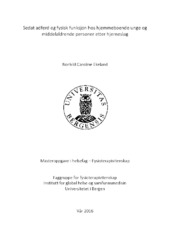| dc.description.abstract | Sedentary behaviour is linked to cardiovascular disease morbidity and mortality. To date, no studies have used objective measures to investigate sedentary behaviour in community dwelling young and middle-aged stroke survivors. Objective: To investigate sedentary behaviour, and its relationship to physical function, in community dwelling young and middle-aged stroke survivors. Methods: Participants were fitted with ActivPAL3 accelerometer and the device was worn 24 hours a day for seven consecutive days, from which sedentary time and transitions per 24 hours were calculated. A questionnaire was used for self-report on sedentary time. Physical function was measured using Short Physical Performance Battery, gait speed, Fatigue Severity Scale, and Becks Depression Inventory. Descriptive statistics and Spearman's rank-order correlation test were used for the data analysis. Results: 13 (31 % women, 69 % men) participated in the study. Median age was 46 years, mean time from stroke onset to testing was approximately 6, 5 months. Participants spent 80 % of the 24-hour day in sedentary behaviours (median = 18,8 hours, IQR =17, 7-20,0 hours), with 51 (IQR) transitions (39-70). Participants underestimated sedentary time by self-report. Sedentary time was weakly correlated with physical function, whereas the correlations between number of transitions and physical function were moderate to strong: Short Physical Performance Battery (ρ =,46), gait speed (ρ =,60), fatigue (ρ =,57) and depression (ρ =,41). Conclusion: Participants were highly sedentary. Further work is required to investigate potential influencing factors and the context of sedentary behaviour in different subgroups post-stroke. Recruiting participants was challenging in this study, and larger, preferably multisite studies are recommended. | en_US |
